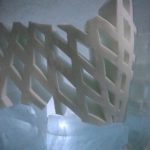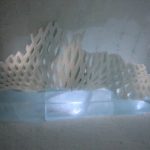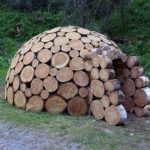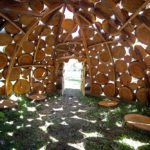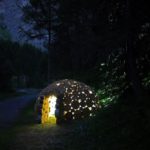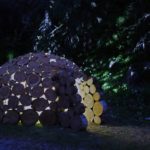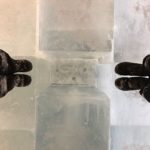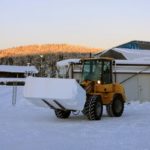It was May when together with my collegue Marjolein Vonk we start thinking about our next frozen adventure. We get inspired by the “plastic soup”. The amount of plastic that is floating every day in the oceans is about 250 thousand tons. Almost impossible to control, and even utopic to clean. From the last research, they found out that some fishing nets survived in the salty water more then 40 years, can you imagine that!
This is a temporary hotel, it will melt down and go entirely back to the Thorne River in late spring, so we made a net that catched up all the Main hall, the Reception, and the ice columns aswell. But our net is a bit special, it will not last for many years in the water, because is just made out of water! It will disappear when the sun will be stronger.
We really wish this will let all the visitors of the 29th Icehotel think a bit more about how we are treating our planet.
Made out of 22 tons of ice and 18 tons of snow, Catch up will be the Entrance, Reception and Main Hall of the Icehotel number 29.
Era il mese di maggio quando, insieme alla mio collega Marjolein Vonk, abbiamo iniziato a pensare alla nostra prossima avventura congelata. Ci siamo ispirati al “mare di plastica”. La quantità di plastica che ogni giorno “nuota”negli oceani è stimata circa 250 mila tonnellate. Quasi impossibile da controllare e addirittura utopistico pensare di raccoglierla. Dalle ultime ricerche, hanno scoperto che alcune reti da pesca sono sopravvissute nell’acqua salata per più di 40 anni, immaginate cosa c’è la dentro!
Questo è un hotel temporaneo, si scioglierà e tornerà interamente al fiume Thorne in tarda primavera, così abbiamo realizzato una rete che ingloba tutta la hall principale, la reception e le colonne di ghiaccio. Ma la nostra rete è un po ‘speciale, non durerà per molti anni nell’acqua, perché è fatta solo di acqua! Scomparirà quando il sole sarà più forte.
Ci auguriamo davvero che questo consentirà a tutti i visitatori del 29 ° Icehotel di pensare un po ‘di più al modo in cui stiamo trattando il nostro pianeta.
Realizzato con 22 tonnellate di ghiaccio e 18 tonnellate di neve, Catch up sarà l’Ingresso, la Reception e la Main Hall dell’ Icehotel numero 29.




